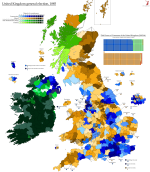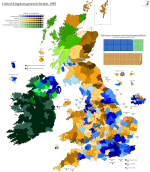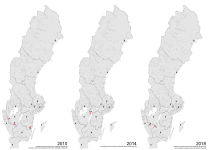Okay, so I've had a map of Sweden's districts done for some time, and the other day I took it upon myself to finish adjusting it to show the parishes that have merged since the Church of Sweden was disestablished. The church tends to follow the rule of subsidiarity as far as this goes, but a lot of parishes (especially rural ones) tended to be so small that, without state support, it was impossible for them to sustain themselves economically. There have essentially been two different ways to deal with this: either several parishes merge into one bigger one, or a number of small parishes (or one large one and several small ones adjacent to it) form a
pastorat, a joint administration where they share a parish priest (hence the name) and an elected council, but retain some measure of self governance (I don't understand precisely what the individual parishes inside a
pastorat actually do, but apparently something). From 2,523 in 1999, mergers have resulted in the church now having 1,292 territorial parishes as well as five non-territorial ones - the Royal Court Consistory, the German parishes in Stockholm and Gothenburg, the Finnish parish in Stockholm, and the Karlskrona Admiralty parish, which is the last of several military parishes that used to exist around the country - and 30 parishes ministering to members of the church who live abroad. They still vary in population from the dozens to the tens of thousands, but most of the very smallest ones have disappeared from the map.

I also figured out that the Church of Sweden releases annual membership statistics for all the parishes, including percentages of the population. This obviously gave me an idea, and here's the map. We can see some general patterns - membership tends to be higher in rural areas, for one, which is not unexpected. Nor is the fact that, in cities with more than one parish, membership is generally lowest in working-class areas with large immigrant populations. The parish with the lowest membership in the country was Bergsjön, in Gothenburg, with 10.6% of the population enrolled in the church, while the highest membership is found in Älekulla, about 60 km to the southeast, where 85.7% of the population are church members. The other two notable outliers are Bergslagen, which is dominated by large industries and tends to be unchurched as a result, and the Bible Belt in the inland south, where independent churches capture a large chunk of the population.






